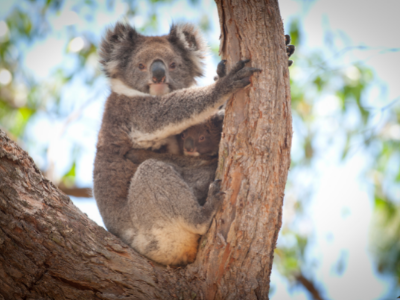19 August 2021
A study to determine how koalas navigate fragmented habitat and their use of isolated eucalypts in the Logan Valley urgently requires the assistance of landholders around Rathdowney and Beaudesert.

Rivalled only by the red kangaroo, koalas are arguably the Instagram-ready face of Australian wildlife. Yet, despite their high tourism profile, these vulnerable marsupials are failing to thrive and continue to decline in South-East Queensland. Image: Marcus Kessler, Canva NFP
The destruction and fragmentation of suitable koala habitat is a major threat to this world-famous, fluffy-eared species, which not only features on Wildlife Queensland’s logo but can also be considered the faunal ambassador for Australian wildlife and the ever-present challenges it faces.
A new collaborative study by the University of Queensland and Logan Valley Koala Project (LVKP), with the support of Wildlife Queensland’s Scenic Rim Branch, is seeking landholders who will allow researchers to survey properties in the Logan Valley throughout August and September for suitable eucalypts and koala activity.
Use of ‘Safety’ Trees
Koalas are territorial marsupials with highly specialised dietary requirements. Increasing development across Queensland’s south-east forces koalas to move between patchworks of eucalypt woodland habitat – whether in protected parks, reserves and corridors or on private property and agricultural land – to seek mates, food and shelter. Being arboreal (tree-dwelling), koalas are cumbersome on the ground, where they are susceptible to vehicle strikes and attacks by feral or domestic dogs and cats.
Running until April 2023, the study aims to identify whether, and for how long, koalas make use of isolated paddock trees on agricultural land for rest, shelter or food trees as they travel between protected corridors and ridgelines.
‘We really need people who believe they may have suitable food or shelter trees on their land, or who have sighted koalas, to step forward and work with us, so we can determine whether koalas are able to find shelter between corridors or protected national parks and reserves,’ explains LVKP Project Manager Ryan Lawrie. ‘Contributors can also provide input through the free to use INaturalist website and app, which simplifies reporting sightings and includes helpful data such as GPS waypoints.’
Several survey methods will be used, including citizen science reporting via INaturalist, roadside surveys conducted by volunteers from the Maibin Jaihilah Yahgilah men’s cultural group, and the deployment of a koala detection dog and ecologist team to conduct on-property surveys. An awareness-raising workshop for October is also being planned.
Following the 2-year study, a research paper of the findings will be published, alongside a data set of GPS positioning of koala activity, which will be added to the public database.
For more information or to get involved, please visit the Logan Valley Koala Project website or email Logankoalaproject@gmail.com.
